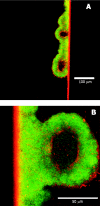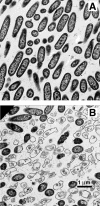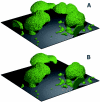Hypothesis for the role of nutrient starvation in biofilm detachment
- PMID: 15574944
- PMCID: PMC535154
- DOI: 10.1128/AEM.70.12.7418-7425.2004
Hypothesis for the role of nutrient starvation in biofilm detachment
Abstract
A combination of experimental and theoretical approaches was used to investigate the role of nutrient starvation as a potential trigger for biofilm detachment. Experimental observations of detachment in a variety of biofilm systems were made with pure cultures of Pseudomonas aeruginosa. These observations indicated that biofilms grown under continuous-flow conditions detached after flow was stopped, that hollow cell clusters were sometimes observed in biofilms grown in flow cells, and that lysed cells were apparent in the internal strata of colony biofilms. When biofilms were nutrient starved under continuous-flow conditions, detachment still occurred, suggesting that starvation and not the accumulation of a metabolic product was responsible for triggering detachment in this particular system. A cellular automata computer model of biofilm dynamics was used to explore the starvation-dependent detachment mechanism. The model predicted biofilm structures and dynamics that were qualitatively similar to those observed experimentally. The predicted features included centrally located voids appearing in sufficiently large cell clusters, gradients in growth rate within these clusters, and the release of most of the biofilm with simulated stopped-flow conditions. The model was also able to predict biofilm sloughing resulting solely from this detachment mechanism. These results support the conjecture that nutrient starvation is an environmental cue for the release of microbes from a biofilm.
Figures







References
-
- Allison, D. G., B. Ruiz, C. SanJose, A. Jaspe, and P. Gilbert. 1998. Extracellular products as mediators of the formation and detachment of Pseudomonas fluorescens biofilms. FEMS Microbiol. Lett. 167:179-184. - PubMed
-
- Applegate, D. H., and J. D. Bryers. 1991. Effects of carbon and oxygen limitations and calcium concentrations on biofilm removal processes. Biotechnol. Bioeng. 37:17-25. - PubMed
-
- Chang, H. T., B. E. Rittmann, D. Amar, R. Heim, O. Ehlinger, and Y. Lesty. 1991. Biofilm detachment mechanisms in a liquid-fluidized bed. Biotechnol. Bioeng. 38:499-506. - PubMed
MeSH terms
Substances
LinkOut - more resources
Full Text Sources
Other Literature Sources

